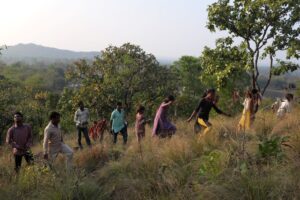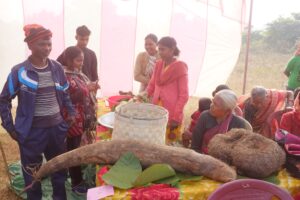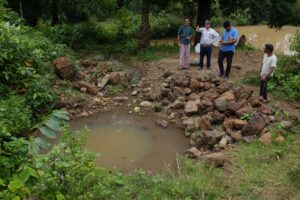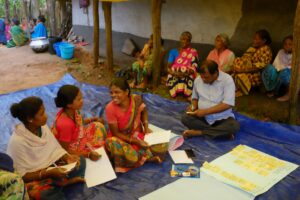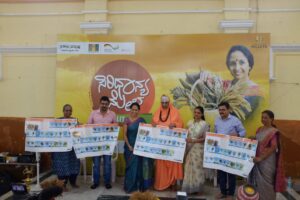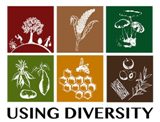Forest Trail in Chettah Pahari Forest neighbouring Malda village – 7th June 2018
Malda is small village located in Podi Block of Korba Distrit, Chhattisgarh. Malda is home to 15 Birhor households which includes the family of Tiharu Birhor the UD community fellow for the Birhor project area. Accompanied by Tiharu and fellow villager Dular Birhor I went for a short forest trail to Chettah Pahari forest. Chettah Pahari was earlier a dense forest with substantial leopard population that gave it its name (Leopards are often locally referred to as Chettahs). However, around 10 to 15 years ago the entire forest was harvested by the villagers. As this forest falls on revenue land (Rajaswah jamin) it did not fall under the jurisdiction of the Forest Department so the villagers were able to cut the forest without any conflict with the Forest Department. The clear felling of this forest came at a cost and resulted is a marked decline in the availability of a large variety of wild food, firewood and other NTFP which was vital to the livelihood and food security of the village. In this regard around 10 years ago the villagers as a whole decided to protect this area and prohibited any felling of trees in Chettah Pahari which has resulted in the return of a moderately dense Senha forest (Senha a medium sized scrubby tree is the dominant species in this forest).
Chhettah Pahari in tune with its most striking landmark Katchua Pathar, is very rocky which is one of the reasons for the relatively sparse vegetation cover. Tiharu pointed out that due to its inherent rockiness and other characteristics tubers are not easy to find in Chhetah Pahari and villagers have to go to different forest areas in search of tuber. Despite this the forest is still home to several species of uncultivated food plants and trees which included:
· Senha – they eat the roots which have medicinal properties and are used in combination with other roots and tubers to made medicine to overcome kamjori (weakness).
· Patwan – the leaves are used as a poison to catch fish.
· Jungli Pyaj – wild onion.
· Karua – whose fruit is boiled and eaten as a vegetable.
· Akol – a black fruit whose roots are also used a medicine for scorpion bites and also to a lesser extent for snake bites.
· Behra – is a brown fruit whose seeds are consumed. But it needs to be eaten in moderation because if it is over eaten there is a fear of getting intoxicated.
· Harra – fruit which is consumed and is good for warding off cough and cold.
· Charota bhaji – whose season coincides with the monsoons was just emerging and is a popular wild leafy vegetable consumed by the birhors.

On our way back to the village we passed Thakur Dahyia the Birhors’ sacred site which comprised of a number of holy stones which marked the place of worship where they make offerings after traditional goat sacrifices.
Interaction with villagers of Malda and Gudu Muda – 8th June 2018
On 8th June morning we had an informal interaction with around 12 men and women villagers of Malda. The concept of the UD project and its key objectives and activities were shared with the villagers. The villagers pointed out that there has been no progress with regards to CFR in the region though some of the neighbouring forest villages have received IFR. The concept of habitat rights was also discussed and villagers were enthusiastic about taking forward efforts to apply for and receive CFR and habitat rights.
 While the villagers pointed out that birhors have not traditionally been an agricultural community, a majority of families have commenced small scale agricultural practices. They expressed an interest in carrying out mixed cropping and kitchen gardens on their lands and some of the seeds they would like to receive form the community seed bank which would be established at Malda were as follows:
While the villagers pointed out that birhors have not traditionally been an agricultural community, a majority of families have commenced small scale agricultural practices. They expressed an interest in carrying out mixed cropping and kitchen gardens on their lands and some of the seeds they would like to receive form the community seed bank which would be established at Malda were as follows:
Seeds for mixed cropping –
i. Rice
ii. Rahar
iii. Urad
iv. Hirua
v. Kodo
vi. Kutki
vii. Jhunga
Vegetable seeds for kitchen gardens –
i. Tomato
ii. Chilli
iii. Baigan/Aubergine
iv. Lauki
v. Karela
vi. Barbatti
The establishment of a community seed bank to cater to the needs of all Birhor project villages at Malda was also discussed and agreed upon. The villagers also pointed out that the making and sale of bamboo products is a major source of livelihood for them but they are now forced to buy bamboo from local farmers and land owners as availability of bamboo in nearby forests has diminished considerably. They were keen to carry out bamboo plantation in their village and pointed out there is land available for community bamboo planting. However, the villagers stated that previous bamboo plantations have failed due to a variety of reasons and expertise and community cooperation would be needed to ensure success of bamboo planting through the UD project.
We also visited Gudu Muda village in Podi block where we interacted with a few villagers. This village has substantial forest areas and most households have received IFR but they are yet to submit CFR claims. The birhor families of Gudu Muda depend on Kari Ghat forest for firewood and a variety of uncultivated food like kolar bhaji, phang bhagi, saroti/mota bhaji, keonjhari bhaji, karva kanda, gathora kanda, kudru kanda, sakar kanda and pitharu kanda. However, the villagers still suffer from insecure land tenure over this forest as they have not been able to compile and submit CFR claims. A future village meeting on plantation of local crops and Forest Rights issues was set up tentatively around 18th June.
Learning
· While Malda village has experienced total clear felling of Chettah Pahari forest by villagers around 15 years ago it is now being protected and has recovered considerably. This forest area falls on revenue land but as pointed out by Tushar there is a need to explore FRA provisions for villagers claiming CFR over this forest area in order to strengthen community tenure and subsequently community management and protection of this forest area.
· Chettah Pahari has a scarcity of tubers and bamboo. The UD project could explore the possibility for promoting bamboo planting in Malda and its forest areas as well as the promotion of tuber varieties. As bamboo products are a primary source of livelihood for the Birhors community bamboo planting in project villages should be looked into. In the light of earlier failed bamboo plantations external expertise should be involved in bamboo planting efforts (possibly LEAF Bastar).
· While Birhors traditionally have not practiced agriculture at any significant levels they are currently adopting settled agriculture practices since they have transited for a nomadic to a relatively settled community. Taking into consideration the needs and demands of local villagers the community seed bank set up through the UD project should promote mixed cropping of a few key local Chhattisgarh crops like rice, rahar, urad, hirua, kodo, kutki and jhunga in addition to a the cultivation of a variety of desi vegetable seeds in kitchen gardens. The seeds can be sourced through PRERAK, UD fellows working in neighbouring areas and other partner organisations.
· While some IFR titles have been give to villagers in forest villages like Gudu Mudu there has been virtually no progress with regards to CFR over community forests that the project villages depend on. There is a need for awareness programs on CFR and support to village communities to compile and submit CFR claims. IFR titles should also be investigated and villagers extended support to address shortcomings in the titles given.


